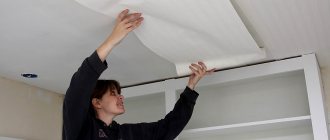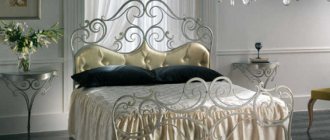How to stop a cat from tearing up furniture
There are many ways that can help you stop your pet from scratching furniture. Let's start with the most popular ones.
Loud sounds, voice command
Every time the cat tries to sharpen its claws on interior items, loudly and sharply say “No!”, “No!”, “Shhh!” Continue this until the pet retreats from its goals.
Note! You shouldn't swear at a cat when it has already sharpened its claws. Do this before or in the first seconds of turning, so that this activity is associated with punishment. The cat must understand why exactly you are scolding him.
The cat must understand why it is being scolded.
Another effective way to wean it from a “bad” habit is ordinary baby rattles . You can buy a rattle or make it yourself - for example, put a few coins in a metal jar (found in the kitchen), seal it and always keep it near you. Noticing that the cat wants to do some mischief again, take the can and rattle it loudly. The animal will quickly run into the next room, because it does not like such strong sounds. Rattle every time to reinforce the learned material!
Balloons are another good “sound” parenting method, although not the most convenient for the owner. Inflate and tie several balloons and secure them at the crime scene. The trap must be designed so that one of the balls bursts during the next claw point. The loud sound will scare away the animal and the next time it will be afraid to approach the ill-fated chair.
The cat is tearing up the furniture
Spray bottle with water
Cats, as you know, do not like water procedures, so why not take advantage of this? Fill a container with a spray bottle with water and spray your pet every time he intends to sharpen his claws in a prohibited place. But do not forget that such a “shower” is effective only before the incident or within five minutes after it, otherwise the animal simply will not understand why it is being punished. Unpleasant sensations, as in the previous case, should be associated with a “crime”.
Spray bottle with water
We arm ourselves with... smells!
Representatives of the cat family cannot tolerate the aroma of onions, vinegar and citrus fruits. It is better to give preference to the third option, since the vinegar disappears quite quickly, and the smell of onions will be unpleasant for you. Mix lemon (orange, tangerine) aromatic oil with the same amount of eucalyptus in a container with a spray bottle. Spray furniture, wallpaper or other necessary items with the resulting solution. The advantage of this method is that it will not only wean the cat from tearing up furniture, but will also fill the home with pleasant odors.
Lemon oil
In addition to citrus fruits, you can use various spices. Pour coriander, ground chili pepper or other strong-smelling seasonings into the bag, then hang it (the bag) in the desired place.
Sticky surface
The feeling of stickiness is just as unpleasant for cats as water procedures, and therefore you can stick double-sided tape on the most attractive places (for example, armrests, the back of furniture).
You can also use special adhesive tape Sticky Paws (translated as “sticky paws”), which can be glued almost anywhere - on the carpet, upholstery, curtains. Such tapes are practically invisible, and therefore will not spoil the interior of the room.
Sticky Paws Cat Tape
Nail trimming
When trimming the sharp part of the claw, you must act with extreme caution, otherwise you may harm your pet. It is advisable to entrust this matter to a qualified veterinarian. Although it is quite possible to learn how to trim your claws yourself. You just need to do this to a certain length and at the required angle, using exclusively special scissors.
Scissors for trimming cat claws
Important! It is strictly not recommended to use scissors for dogs! The shape of the claws of these animals is different! And after trimming, be sure to reward the cat so that the process is not just torture for him.
Proper trimming of cats' claws is the key to the success of the entire procedure.
Closed doors
If there are any expensive items in the room, keep the doors closed as soon as the cat arrives. Choose a type of doorknob that will not open if the animal pushes with its paws.
Door lock
Or you can make such a device at the bottom of the door leaf.
Screw at the bottom of the door
Video - How to stop a cat from tearing up the sofa and wallpaper
scratching post
An excellent solution to the problem. Typically, you can make a scratching post with your own hands, but to do this you need to take into account several important nuances.
- The place should be as comfortable as possible for the pet.
- The height should correspond to his height.
- The scratching post must be secured securely so that it can withstand the load.
- The top layer should be made of a rough material of medium hardness, reminiscent of tree bark. An excellent option is sisal rope, although you can use other materials.
Scratching post on the wall
The cat always considers himself the master of the house, and therefore is unlikely to limit himself to just one place to demonstrate his power. If you have a large apartment or you are the happy owner of several cats at once, it is better to place 2-3 scratching posts where the animals most like to be.
Kittens and scratching post
Scratching posts for cats
Why do cats tear up sofas?
The answer to this question lies in the nature of the cat family. Any cat has a set of instincts that it has preserved and displays at home. Why do cats scratch furniture and wallpaper? Let's look further.
Indicate the boundaries of their territory
There are glands near the pads of a cat's front paws. By scratching a suitable surface, the cat stimulates them to release an odor that is imperceptible to the human sense of smell, but noticeable to cats. In addition, a visual mark is used - scratches.
Sharpening claws
The renewal of the stratum corneum of a cat's claw occurs by shedding its top layer. To do this, the cat chews it off or gets rid of it with the help of the owner's favorite carpet.
By tearing up wallpaper, cats sharpen their claws.
Stretch their paws
By scratching furniture and carpets, the cat stretches its muscles, stretches, and trains its claw retraction mechanism. This is exercise for the cat.
Relieve stress
By scratching surfaces, the animal relieves nervous tension. If the situation in the house is tense, cats often scratch wallpaper and furniture.
Kittens also scratch objects that interest them. Most often, they do this for informational purposes. Tactile sensations help the kitten explore the object and its properties. Juveniles may scratch furniture as they play, clinging cheerfully to them like a wild cat.
Each cat prefers its favorite material for sharpening its claws: some prefer vinyl wallpaper, while others only like carpet.
Cats can also tear wallpaper due to extreme stress.
Making a scratching post with your own hands. Master Class
Let's look at one simple and inexpensive way to make a cat simulator. To do this, prepare in advance:
- a round wooden plate (ø35 cm), cut it out before starting work;
- tape (yellow, pink or white);
- wooden beam (40x40 mm) 0.7 m long;
- scissors;
- electric drill, screwdriver, and wood screws of sufficient length;
- glue, construction stapler;
- white cover (40x40 mm), these are used for switches;
- white paint;
- nylon rope (50 m);
- fabric dye (yellow or pink).
A beautiful scratching post made from scrap materials
Step 1. After preparing everything you need, you can start making your own scratching post. First, secure the beam in the center of the base. It is important to accurately determine the center of the circle, otherwise the appearance of the entire product may be spoiled. After fixing, paint the circle with white paint.
The post is attached to the center of the base
Step 2: Start painting the rope. By the way, this rope is lighter in color and therefore better than sisal or jute. Although nylon itself is less durable, this is not so important - scratching posts do not last very long, their service life (both homemade and purchased) is limited.
Painting nylon rope
Step 3: When dyeing, follow the instructions that came with the fabric dye. Then the rope should dry thoroughly, for which it can be laid, for example, on a radiator. This may even take the whole night, so it is better to postpone further work until the next morning. Moreover, during this time the smell of the paint with which you painted the round base will have time to disappear.
The rope must dry well
Step 4. You can start winding. To begin, nail one end of the rope to the block, as shown in the photo below. Also be sure to spread the glue all over the post. If you use ropes of different colors, connect them using colored tape (pink on the pink area, etc.). Seal the joint between pink and yellow with pink tape, which will look like a continuation of the pink edging. This is why you don’t need to buy tape in all three colors.
The post is wrapped with rope
Step 5. Secure the second end of the rope on top with the same stapler, and cover the remaining area with a plastic cover. In the absence of the latter, simply paint the area or decorate it as you wish.
The remaining area is covered with a lid
Step 6. The scratching post is ready for use! If you don’t have the time/energy/desire to make this option, you can try making another one (step-by-step instructions are given below).
Photo of the finished scratching post
Table. Making a scratching post from corrugated cardboard.
| Steps, photo | Description of actions |
| Step 0 | To begin, prepare everything you need - thick corrugated cardboard, a screwdriver, a template with diagrams of all levels of the future design, an electric drill, a wooden dowel, a knife for cutting cardboard, screws, plywood, as well as a convenient surface on which you will cut the levels. |
| Step 1 | Mark the center of the plywood base. Take a drill and, placing plywood between a pair of chairs, drill a hole at the mark. |
| Step 2 | Next, using the same drill, drill a hole in the center of the dowel, as shown in the image. This hole will make the next step much easier for you. |
| Step 3 | Take a screw, screw it into the board, and then screw the wooden dowel to the plywood base. Holding the screw with a screwdriver, take the dowel with your other hand and screw it (the screw) to it. It is important to hold the dowel until it is screwed tightly. Manually screwing in the dowel allows you to control the process and, as a result, fix the element straight. |
| Step 4 | Start cutting out the templates. Prepare in advance and then print out templates for all seven levels of the future product. Templates should be drawn on cardboard and cut out. |
| Step 5 | Take the templates and use them to draw shapes on the corrugated cardboard. |
| Step 6 | Cut out the layers along the contour. Using a knife, use a knife to cut out the cardboard using the drawn outline. It is important that the knife you use is sharp, otherwise you may damage the cardboard. |
| Step 7 | Start assembling all layers. Stretch the cut cardboard layers one by one onto a wooden dowel. There is no need to glue the layers together - this will allow you to replace one of them in the future if damaged. |
As a result, you will get something like this scratching post. As you can see, there is nothing complicated here; the work can be completed in just a couple of hours.
DIY scratching post for cats
Below is another interesting option - a small claw in the shape of a fish . Although you can choose any other shape. The idea is to cut corrugated cardboard into strips 10 cm wide and gradually wrap them around each other. However, all stages of production are shown below.
DIY scratching post in the shape of a fish
How to train a cat to use a scratching post?
The “unit” for sharpening claws is usually located where the pet is used to doing it. As mentioned above, if there are several such zones, then there should be the same number of scratching posts (ideally).
- If the animal has its own sleeping place, then the scratching post should be placed there (cats always warm up after waking up).
- You can show your cat how to use a scratching post - first of all, move his paw along the column (this should be repeated several times).
- It is better to cover or take away all distracting objects so that the pet can focus more often on the scratching post.
- Place foil, adhesive tape or slippery plastic on the floor in the place where the cat likes to tear wallpaper or furniture.
Getting the cat used to the scratching post
Note! Every time your pet uses the scratching post, reward him, pet him and give him compliments.
You should not lure your pet to the grinding “unit” with valerian. Having gone crazy, the cat will bury its nose in the scratching post, rub against it, meow loudly and perform various circus acts, without even remembering its direct purpose.
You can show by example how to sharpen your claws
Attach a dangling toy to the structure. This will additionally draw attention to the design. While playing, the pet may guess that the structure can sharpen its claws.
When you come home in the evening, do not pet the cat until you reach the scratching post (it is recommended to place another structure in the hallway). Walk up to the structure, scratch it and greet the cat. If it comes up and starts sharpening its claws, then remove your hands from the structure and pet the animal. Don't forget to praise the fidget.
Other methods of raising a pet
Try using other methods - it is quite possible that one of them will help bring your cat to reason.
- Aerosol. Let’s immediately make a reservation about the dubiousness of this option, since usually mustachioed people still continue to scratch furniture treated with special sprays.
Beaphar Stop It repellent spray for cats - Protective covers. They are stretched over furniture not only to protect against pets, but also to cover tattered fabric. According to manufacturers, elastic covers are not very suitable for cat activities due to mobility and low stability. Stretch covers are quite easy to clean and wash, and their cost is noticeably lower than a new chair.
Sofa with cover - "Soft Claws". If you don’t want to bother with covers, rattles, tape, etc., you can pay attention to the animal’s claws. For example, you can put special silicone attachments on the claws of the front paws, which follow the shape of the claw and are attached with glue, but do not hinder reflex movements. That is, the claws will calmly retract and extend. Typically, such caps come off along with the stratum corneum after 2 months, but if desired, they can be re-glued.
Anti-scratch for cats - Declawing. A radical method that only heartless owners resort to. Onychectomy is a surgical operation during which the claws are amputated along with the phalanges of the fingers. As a result, the pet becomes disabled - the coordination of its movements is impaired, the cat constantly loses its balance, cannot stay on heights, its spine hurts, and its posture is disturbed. If such an animal ends up on the street, it will find itself completely defenseless there.
Cat declawing is not a cosmetic procedure, not a “pedicure”, but a serious operation during which the phalanges of the fingers are amputated
What not to do
Most people do not know that their prohibitions and threats do not apply to cats. The animal will always do what it wants, without taking into account your opinion. Therefore, when weaning Vaska from a bad habit, remember some important points.
- You should not resort to any physical punishment (the pet will harbor a grudge and will definitely take revenge on you).
- Shame the cat only during the “crime” (belated lectures will not bring him sense).
- You should not throw away an old scratching post, the smell of which is familiar to the animal (it will have great difficulty mastering a new one).
- Finally, you should not yell at your cat (use intonation, but not volume of voice).
Owners of cats who exercise daily are lucky in this regard, because any tree is a large scratching post, for the use of which no one will swear.
Video – How to stop a cat from sharpening its claws on furniture
What to do if the methods you use do not help
Cats are picky pets. If the cat doesn't like the scratching post, he won't use it. You can reduce the damage caused by cat claws using the following methods:
- Trim the claws on the front paws (only the tip free from the vessel is cut off);
- Place removable covers on furniture;
- Install different types of scratching posts in different rooms;
- Move furniture so as to make it difficult to reach the favorite scratching spot;
- Make renovations “for pets”;
- Eliminate access to the room where the cat scratches;
The abundance of methods presented creates comprehensive protection for property from cat claws. If one method is not suitable, use another.
The main thing is to provide the cat with an alternative and point out the areas allowed for scratching.
If the apartment has expensive furniture and decoration, and the cat is not allowed to run and frolic, it is better to find her another home. The presence of animals in the home always implies some damage. Animals are raised from an early age, using only non-violent methods.
How to buy a cat?
If you are interested in whether there are “well-bred” cat breeds in the world, then we have to disappoint you - alas, there are none. But there are some practical tips that will help you when buying a pet:
- buy a three- or four-month-old kitten (the character is already indicated, and the owners probably taught him to use a scratching post);
- give preference to breeds that are focused on communicating with people (for example, British Shorthair) to make it easier to achieve mutual understanding;
- In terms of neatness, a purebred cat can surpass even the most purebred “competitors . But here it is better to purchase an already adult pet, so as not to buy, so to speak, a pig in a poke.
5/5 (7)
What coverings are cats indifferent to?
Cats don't like sticky surfaces. You can protect your furniture by placing double-sided tape or sticky paw tape in the area where your pet prefers to sharpen its claws.
Decorative plaster, ceramic tiles, linoleum or laminate will also not interest the kitten. To prevent damage to the wallpaper, you can use these materials to decorate the walls.
Aluminum foil and other smooth, sliding surfaces will not please your pet.
You can temporarily seal the area where the cat began to leave scratches with bubble wrap. Since the claws get stuck in it, the animal will stop damaging the furniture.











